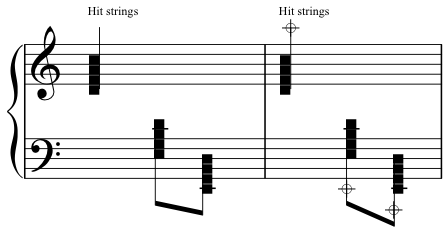Hit strings
The palm of the hand can be used to hit the strings.
Production
The harpist hits the strings with the palm of the hand, held horizontally. The harpist can either let the strings ring after the hit or leave the hand on the strings, thus muting them. (See video below).
Sound
Hitting the strings produces a cluster sound. The volume depends on the power of the attack and on the range in which the strings are hit. The longer wire strings can obviously sound louder than the higher and shorter gut strings. The quality of the sound differs a great deal between the wire and the gut strings.
Notation
The hit is notated as a cluster in the relevant range. Since this is a percussive effect the notation only indicates the approximate range in which the hit occurs, it is not meant to represent the exact strings being hit.
A written explanation should be included, either where the cluster appears or in the works legend. One hand usually hits an interval of approximately ten strings. If a muted cluster is wanted a damping sign should be written on the stem of the cluster.
Pedal settings should be indicated with pedal diagrams. The pedal setting influences the sound of the resonance of the hit. However it is good to keep in mind that this effect is a percussive one and it can be difficult to control the exact sound of the resonance. For example, the hand does not hit all the strings with equal strength so some strings might resonate more than others.

Hit strings, sounding/muted.
Range
Although this effect is mostly used in the lower range of the harp, all strings can be hit with the palm of the hand. In the top octave however, there is little space for the hand to hit the strings and the effect is minimal.